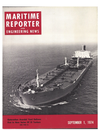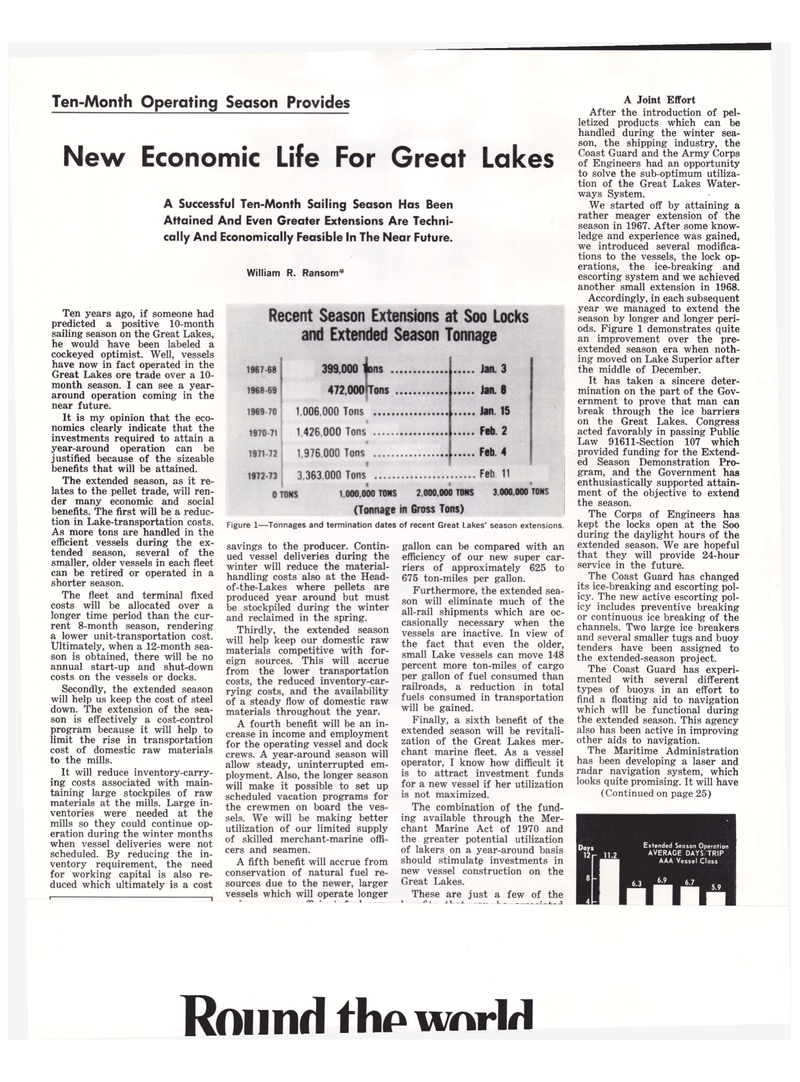
Page 18: of Maritime Reporter Magazine (September 1974)
Read this page in Pdf, Flash or Html5 edition of September 1974 Maritime Reporter Magazine
Ten-Month Operating Season Provides
New Economic Life For Great Lakes
A Successful Ten-Month Sailing Season Has Been
Attained And Even Greater Extensions Are Techni- cally And Economically Feasible In The Near Future.
William R. Ransom*
Recent Season Extensions at Soo Locks and Extended Season Tonnage 1967-68 1968 69 1969 70 1970-71 1971-72 1972-73 3,000 ion 72,000 fTo 399,00 ions 472,OOOHons 1.006.000 Tons 1 426.000 Tons 1,976.000 Tons
Jan. 3
Jan. 8
Jan 15
Feb. 2
Feb. 4 3.363,000 Tons Feb 11 ! » « 0T0NS 1.000,000 TONS 2.000.000 TOMS 3,000.000 TONS (Tonnage in Gross Tons)
Figure 1—Tonnages and termination dates of recent Great Lakes' season extensions
Ten years ago, if someone had predicted a positive 10-month sailing season on the Great Lakes, he would have been labeled a cockeyed optimist. Well, vessels have now in fact operated in the
Great Lakes ore trade over a 10- month season. I can see a year- around operation coming in the near future.
It is my opinion that the eco- nomics clearly indicate that the investments required to attain a year-around operation can be justified because of the sizeable benefits that will be attained.
The extended season, as it re- lates to the pellet trade, will ren- der many economic and social benefits. The first will be a reduc- tion in Lake-transportation costs.
As more tons are handled in the efficient vessels during the ex- tended season, several of the smaller, older vessels in each fleet can be retired or operated in a shorter season.
The fleet and terminal fixed costs will be allocated over a longer time period than the cur- rent 8-month season, rendering a lower unit-transportation cost.
Ultimately, when a 12-month sea- son is obtained, there will be no annual start-up and shut-down costs on the vessels or docks.
Secondly, the extended season will help us keep the cost of steel down. The extension of the sea- son is effectively a cost-control program because it will help to limit the rise in transportation cost of domestic raw materials to the mills.
It will reduce inventory-carry- ing costs associated with main- taining large stockpiles of raw materials at the mills. Large in- ventories were needed at the mills so they could continue op- eration during the winter months when vessel deliveries were not scheduled. By reducing the in- ventory requirement, the need for working capital is also re- duced which ultimately is a cost savings to the producer. Contin- ued vessel deliveries during the winter will reduce the material- handling costs also at the Head- of-the-Lakes where pellets are produced year around but must be stockpiled during the winter and reclaimed in the spring.
Thirdly, the extended season will help keep our domestic raw materials competitive with for- eign sources. This will accrue from the lower transportation costs, the reduced inventory-car- rying costs, and the availability of a steady flow of domestic raw materials throughout the year.
A fourth benefit will be an in- crease in income and employment for the operating vessel and dock crews. A year-around season will allow steady, uninterrupted em- ployment. Also, the longer season will make it possible to set up scheduled vacation programs for the crewmen on board the ves- sels. We will be making better utilization of our limited supply of skilled merchant-marine offi- cers and seamen.
A fifth benefit will accrue from conservation of natural fuel re- sources due to the newer, larger vessels which will operate longer gallon can be compared with an efficiency of our new super car- riers of approximately 625 to 675 ton-miles per gallon.
Furthermore, the extended sea- son will eliminate much of the all-rail shipments which are oc- casionally necessary when the vessels are inactive. In view of the fact that even the older, small Lake vessels can move 148 percent more ton-miles of cargo per gallon of fuel consumed than railroads, a reduction in total fuels consumed in transportation will be gained.
Finally, a sixth benefit of the extended season will be revitali- zation of the Great Lakes mer- chant marine fleet. As a vessel operator, I know how difficult it is to attract investment funds for a new vessel if her utilization is not maximized.
The combination of the fund- ing available through the Mer- chant Marine Act of 1970 and the greater potential utilization of lakers on a year-around basis should stimulate investments in new vessel construction on the
Great Lakes.
These are just a few of the 1 ^ ' 11--1 1 - - _ J X
A Joint Effort
After the introduction of pel- letized products which can be handled during the winter sea- son, the shipping industry, the
Coast Guard and the Army Corps of Engineers had an opportunity to solve the sub-optimum utiliza- tion of the Great Lakes Water- ways System.
We started off by attaining a rather meager extension of the season in 1967. After some know- ledge and experience was gained, we introduced several modifica- tions to the vessels, the lock op- erations, the ice-breaking and escorting system and we achieved another small extension in 1968.
Accordingly, in each subsequent year we managed to extend the season by longer and longer peri- ods. Figure 1 demonstrates quite an improvement over the pre- extended season era when noth- ing moved on Lake Superior after the middle of December.
It has taken a sincere deter- mination on the part of the Gov- ernment to prove that man can break through the ice barriers on the Great Lakes. Congress acted favorably in passing Public
Law 91611-Section 107 which provided funding for the Extend- ed Season Demonstration Pro- gram, and the Government has enthusiastically supported attain- ment of the objective to extend the season.
The Corps of Engineers has kept the locks open at the Soo during the daylight hours of the extended season. We are hopeful that they will provide 24-hour service in the future.
The Coast Guard has changed its ice-breaking and escorting pol- icy. The new active escorting pol- icy includes preventive breaking or continuous ice breaking of the channels. Two large ice breakers and several smaller tugs and buoy tenders have been assigned to the extended-season project.
The Coast Guard has experi- mented with several different types of buoys in an effort to find a floating aid to navigation which will be functional during the extended season. This agency also has been active in improving other aids to navigation.
The Maritime Administration has been developing a laser and radar navigation system, which looks quite promising. It will have (Continued on page 25)
Round thp wnrlH

 17
17

 19
19
